
Cardiff is a capital of some sort. Architecturally and topographically it feels internationalist yet utterly local, dynamic but afraid of the unfamiliar. If it resembles another European city, it is Brussels, albeit on a far smaller scale: a reluctant, bureaucratic capital, largely aloof from the linguistic and nationalistic conflicts that surround it, its industrial base mostly dead, but with a thriving sideline in administration. Yet in British terms it feels somewhere between Southampton (not quite so mean, a bit more ambitious, freer) and Liverpool (whose port-metropolis grandeur it sometimes attempts, but tentatively). It’s a puzzle of a city, and mostly a very worthwhile one, if not always for architectural reasons. Sadly a lamentable provincialism and parsimony means that in places, we have a ceremonial capital designed by such giants as Benoy, Crapita and, if we’re feeling a bit naughty, BDP. It’s pathetic, and when criticized is invariably justified via a strange circular argument—how dare some jumped-up ponce from London come here and slag off our brilliant buildings? Anyway, the reason they’re so shit is because of our clients and it’s not our fault, so there.
Two parts of central Cardiff appear to be competing for the role of the Welsh capital’s administrative centre, both of them built from scratch—one of the early twentieth century, another of the early twenty-first. The earlier of the two is at Cathays Park, near Cardiff Castle’s Gothic fantasia. Laid out in wide, tree-lined boulevards, with plenty of green space, reached by the appropriately francophone Boulevard de Nantes, it’s what I imagine imperialist capitals in Africa or Australia to look like, something which says odd things about Wales’ status in the United Kingdom but complimentary things about the ambition of its politicians. The ensemble feels a bit dated for its period, the buildings mostly examples of an imperial neoclassicism already outmoded by the time of completion in the thirties, but at this distance it’s thoroughly impressive, the free baroque of Lanchester, Stewart & Rickards’s City Hall especially. This really feels like a capital, albeit a colonial one, but the Welsh Assembly’s Senedd is at the other end of the city, overlooking the port at Cardiff Bay. Here is a staggeringly different urban experience, in a fashion which is not kind to the twenty-first century.
Cathays Park
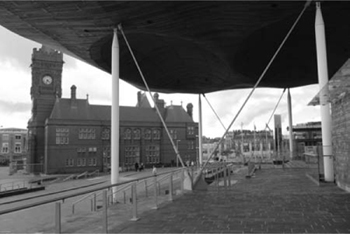
Senedd meets Pierhead
‘Cardiff Bay’ was once the beautifully named Tiger Bay, for decades the UK’s most multiracial area outside London. The name has been obliterated, along with much else; in a city scrabbling around for any shred of heritage, this effacement is bitterly ironic. Defining it are two major buildings by the architectural wing of Private Eye favourites Capita—a thuggishly dull, spiritcrushing, dead-eyed Police Station by Capita Symonds, and the less appalling Millennium Centre, of which more anon. While it may be dressed with volkish public art and rubble stone, the Police Station is a veritable behemoth of punishment—it increased the amount of cells in the previous central station from four to sixty. It also has a range of exciting security features. Apparently, ‘full integration allows for the operation of multiple systems from one holistic front end—with high levels of control’. Comforting, no?
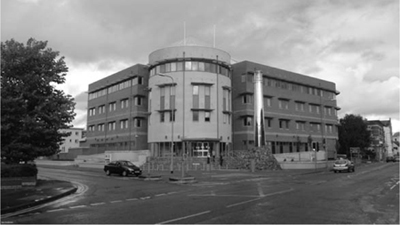
The New Police Station
We were given a clue as to the reasons for this when we watched ‘Cardiff Carnage’ sweeping through the centre. This militarized pub crawl was a thing to behold—hundreds of freshers, all clad in promotional T-shirts with writing all over both T-shirts and themselves—marker pens were given out so they could cross off each pub on the list. They were doing all the expected things—drink fall over be sick snog knee-trembler if you’re lucky, etc—but on such an enormous scale that there were fluorescentjacketed stewards on hand, as if this was a political demonstration. The stewards seemed to be there to channel and watch the students, ringing ambulances if necessary, but in the context it seemed more as if, along with the traditional role of providing liaison with the police, they were there to protect the youth from the possible wrath of Cardiff. I’ve never before seen fun of such a weirdly desperate, over-organized yet nonetheless spectacularly dissolute sort. Without getting too Daily Mail about it, it was hard not to feel terribly sorry for them all: even the defenders of this curious event know it’s done to blot out the imminence of impending debt and temp hell. You can be as hedonistic as you like, as long as you’re prepared to be indentured for it for the rest of your life.
The place we saw all this occur was St Mary’s Street. Architecturally this really is a fabulous place, its impressiveness barely affected—possibly improved, for some—by hordes of screeching petit-bourgeois virgins covered in marker pen groping each other before being sick in the gutter. This street is a great, complex urban object, a continuous block with each of its buildings differently styled (hence the comparison to Belgium, where by-laws ensure diversity), ranging from loud low countries Gothic to two massive Americanized neoclassical department stores, one of which was once the hulking headquarters of the local Co-Operative; on the other side of the road, the buildings lead into markets and arcades. Not all of central Cardiff is this interesting, but there’s a tendency not to take architecture too seriously, a sentiment which, while perhaps at the root of the cut-price botch job of Cardiff Bay and the invariably dreadful towers, can be quite entertaining. The Cardiff Cineworld and the cluster of buildings near the Millennium Stadium, while never quite being good, have at least a bit of fun with our prevailing Modernism on the cheap, dressing themselves up in neon when night falls—similar low pleasures can be found in HOK’s Millennium Stadium itself, although it’s a shame the struts are painted white, when black or red would have taken the admirable tastelessness to a more charismatic level. In the middle of this is one fine bit of late Brutalism, Seymour Harris Partnership’s 1982 St David’s Hall, looking improbably chic and European Grey by comparison. The St Mary’s Street area is one of two really very good things in Cardiff, the other being the aforementioned imperialistic Beaux-Arts pleasures of Cathays Park—which, interestingly, was planned decades before Cardiff was designated ‘capital’ of Wales, and yet it is laid out with confident gusto as if it already were. It’s this which makes the comparison between Cathays Park and Cardiff Bay so irresistible, in that both were explicitly laid out as bureaucratic and cultural centres (with some retail added in the new version). The former Tiger Bay became, as with Greenwich Peninsula and the Cardroom Estate in Ancoats, a Blairite tabula rasa, and like them it remains fundamentally unfinished a decade later. Even Lloyd George Avenue, the ceremonial boulevard towards the new district, was botched and is likely to remain unfinished, with anything slightly adventurous in the original proposals—interesting planning, light transit—replaced with a mere road from A to B. Still, it’s all there at Cardiff Bay—wonky sub-decon, New Urbanist-indebted ‘proper streets’, yuppiedromes; and upriver, lots of call centres—and none of it seems to notice its fellow buildings, let alone exhibit a spark of personality. But among the more innovative things done here was the creation of a new Barrage at enormous expense, the sole reason for which seems to have been the assumption that muddy water would have deterred people from moving into the adjacent condos.62
Cardiff Cineworld
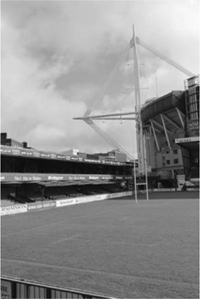
Stadium struts
Capita Percy Thomas’s Millennium Centre suggests that Crapita has managed to absorb some moderately talented architects. Best known for replacing Zaha Hadid’s competition-winning opera house, it’s oft reviled but far from all bad—its futuristic vernacularisms are populist and original, if ever so slightly patronizing. There are another two ‘landmark’ buildings here, William Frame’s fine, rather Liverpudlian Pierhead, and Richard Rogers’s Senedd. Rogers Stirk Harbour too often temper their Gothic impulses in favour of ‘nice’ architecture, and from the outside the Senedd is decidedly low-voltage for its site, giving little to those who treat architecture as objects to look at and enjoy, although the interior is reputedly impressive. What is around it, however, is motley, to put it politely. The washed-up tube of Will Alsop’s rusty visitor centre and a reconstructed Norwegian Church at one end are the good side of this chaos, but are dwarfed by Benoy’s Mermaid Quay on the other side. Here are manifold fashionable gestures of the 2000s at their most banal—vaguely nautical, vaguely decon roofs aligned on ‘real streets’, often looking curiously like budget versions of the Senedd’s wonky roof over glass box approach. What is especially noticeable here is how badly planned all this is, how disconnected each cluster is from the other, how each completely ignores its neighbour. None of the buildings have the architectural courage to make a virtue of this disconnection. The abundant and lumpenly literal public art is really not enough to stitch it all together, and so this gift of a site is wasted.
St David’s Hall, trying to look cool
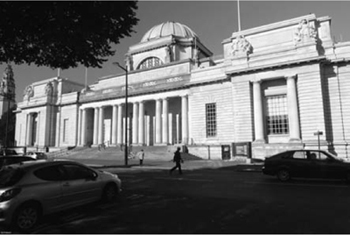
National Museum and Gallery of Wales, Cathays Park
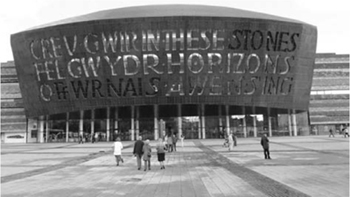
Future vernacular at the Millennium Centre
Alsop’s Visitor Centre
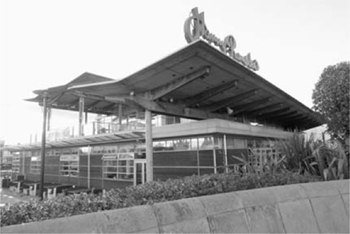
Harry Ramsden’s, Mermaid Quay
Along the River Taff, there are two routes back to the centre. The western route goes along the well-preserved Victoriana of Grangetown—the houses are set back from the river, and behind there are squares, a Hindu temple and a welcoming liveliness coexisting with seaside town sleepiness, marred only by the clogging up of the streets by parked cars; something which those who hanker after the Real Streets of the nineteenth century always fail to notice. This pleasant averageness is rudely interrupted by Wildig Lammie’s Fitzhamon Embankment, a block of student housing that improbably combines neo-Victorian postmodernism in cheap stained stone and brick, ‘nautical’ porthole windows, and regeneration-signifying Iconic jagged roofs. It’s quite possibly the worst new building we’ve seen all year, but it’s so cheerfully awful that it’s hard to hate it entirely.
Although overlooked by Cardiff’s few postwar municipal towers, surviving industry and call centres, the eastern route would no doubt consider itself rather classier. Its main interest is WYG’s Century Wharf, riverside yuppiedromes with no public access to the river. The flats are now going pretty cheap, revealing that these are no longer the exclusive enclaves they present themselves as, though they still retain their aggressive gating against the city around. No surprises here, you know the drill—render, concrete balconies, irregular windows, sub-Parker Morris standards, lots of materials. Yet as it taketh away, Blairism also giveth. Strata, the newest part of the development, features an ‘Animal Wall’ to accommodate the creatures that may otherwise have been displaced, and it’s curious to see that in terms of both interesting design and social policy the birds have been having a better time of it than the humans. The Wall achieved the rare accolade of an article at the website of architectural pornographers Dezeen. Amusingly, one commenter compares the bird wall to a ‘socialistic concrete apartment block’. Perhaps the birds and bats need something in their vernacular?
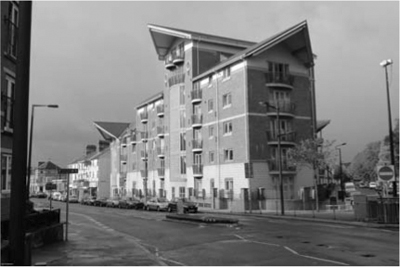
Architectural comedy at Fitzhamon Embankment
‘Strata’
The commercial centre, meanwhile, is better in details than from a distance; while at first you notice the tacky new or clad towers, closer inspection is chaotically rewarding, with layer upon layer of conflicting styles. It’s currently centred round St Davids 2, the latest outgrowth of the covered shopping centres that were built here as early as the 1850s. There’s a juxtaposition which clearly wants to be a new civic ‘hub’, where BDP’s new library meets Benoy’s (mainly unlet) Hayes Apartments and John Lewis. The prow-like corner apparently represents the port—an easier device to justify here than in the many inland British buildings that employ it. The library, part of the same development (they’re giving something back, so kind), is mannered on the outside; a barcode façade that is clearly indebted to David Adjaye’s similarly striped east London ‘Idea Stores’, meeting copper cladding, with a vaguely organic bulging floor-plan. The entrance to Wagamama is clearer than that of the library itself. The interior is better, balancing activity, quietness and abundant natural light, with a hint of Brutalism about the bare concrete circulation spaces, slightly making up for the desperation outside. From here you can survey the most striking object on the Cardiff skyline, the Millennium Stadium, which is audaciously crammed right into the area’s bustle, huge girders and cantilevers single-handedly providing the dramatic skyline which would otherwise be absent from the city. On the ground it clips itself onto the earlier Cardiff Arms Park, its 1969 concrete structure still impressively harsh.
Inside the new library
The shopping spaces are by a considerable measure most interesting in the Arcades and markets hidden along St Mary’s Street, which boast some wonderfully imaginative moments—the point where the ferro-vitreous roof of Edwin Seward’s 1879 Morgan Arcade curves round the street line is fantastical, as is the secondhand bookshop adjacent, despite an incongruously twee Wedgwood paintjob. The City Market, designed by William Harpur in 1891, and the other Arcades are similarly diverse, especially compared with the identikit fare in the St David’s Malls. Near here, a couple of edifices suggest a world beyond shopping: the complex late Brutalism of St David’s Hall, and a forlorn statue of Aneurin Bevan, now stuck between McDonalds and Bradford & Bingley. Pigeons may have relieved themselves on him, but at least the great man didn’t have to see Cardiff Carnage.
Learning and retail
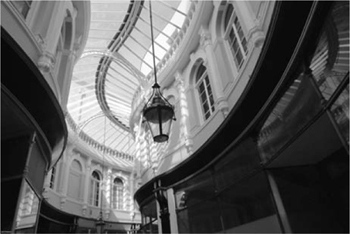
Morgan Arcade
Cardiff is marvellously rootless and cosmopolitan. It has no vernacular. At its edge, St Fagans pointedly brings authentic Welsh architecture to the capital. It’s a park full of reconstructed rural buildings set up from the 1940s onwards, commissioned by the Earl of Plymouth, who was worried about the possible expropriation of his land by Bevan’s Labour government. Maybe he was influenced by the similarly anti-socialist Henry Ford’s prototheme park Greenfield Village, an open-air museum of the American vernacular, but this—assembled by Welsh nationalist Iorwerth Cyfeiliog Peate—would be more about scholarship than entertainment. Heralded by a neat, clean-lined visitor centre in the style of the day (the day being 1968), St Fagans is like a spacious, studious version of Clough Williams Ellis’s North Wales fantasy village Portmeirion, only with all the joy extracted. It started off with North Walian farmhouses, mills, speculative prehistoric Brythonic villages and timber circles, but has since reconstructed fragments of industrial South Wales: a row of shockingly mean miners’ cottages from Merthyr, a wonderfully imaginative Miners’ Institute torn out of Oakdale, Caerphilly, all decontextualized and rebuilt for our comfortable exploration. It’s Baudrillard at the Eisteddfod. Some of it implies there might have been a real vernacular a very long time ago, with steeply overhanging roofs and lots of whitewashed stone in evidence; in the case of a pit for cockfighting, there’s some impressively complex wood framing. Nonetheless, the reason why this poverty ought to be emulated as a model for today—as it is with similar studiousness in Poundbury, not too far away in the West Country—remains entirely mysterious.
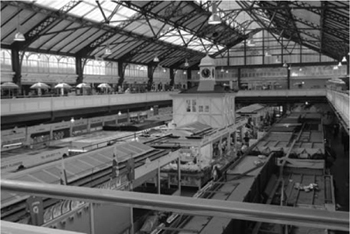
Cardiff Central Market
The transplanted Miners’ Institute
Its paths loop around a couple of reconstructions of the future, too—a 1948 prefab and, cordoned off near the entrance, the House for the Future. Obviously a rather ambitious gesture for a place devoted to reconstructing the past, the construction of the future has been enduringly controversial. A large house designed by Jestico & Whiles and paid for by developers Redrow, like the Merthyr cottages it’s flat at one end and dramatically sloping at another. It went through a series of metamorphoses, rebranded in more vernacular fashion as Tŷ Gwyrdd, the House for Sustainable Living. The combination of green technology with luxury didn’t provide a realistic model of the future, so it closed recently because of ‘technical problems and a negative reaction from the public’ (according to an extremely helpful staff member who lets us sneak in when the Park is closing). It is not altogether surprising that a constructed past has no room for the future, but the centre of Cardiff ought to be able to offer a more convincing idea of where we should go from here. Although its civic ambitions coexist with commercial blandness, I have more hope in it than I could ever have in St Fagans and all it represents.
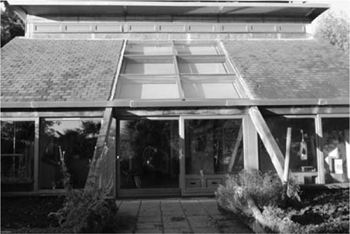
The House for the Future
Past the visitor centre (as we stood taking a picture of it, the CCTV camera swung round to look at us), St Fagans provides the Vernacular Experience, a park where you can look at everything from piggeries to prefabs. Although the prevailing implicit argument is for the ‘authentic’ (and, as you can find out for yourself, the unfit-for-human-habitation) architecture of rural Wales, plonked in a capital which voted an overwhelming No in the referendum for the Welsh Assembly, the excursions into industrial south Wales are the most tragic. There’s the House for the Future, the miners’ terrace, and most of all the Oakdale Miners’ Institute: now that the coalfields in the Valleys have gone from being Cardiff ’s reason for existence to being its outer suburbs, they can be safely commemorated, their institutions of self-education torn out and re-rooted in the fallow soil of compulsory heritage. I have a mole in St Fagans, and he told me the following about the failure of the House for the Future:
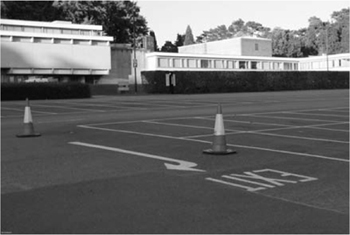
St Fagans Visitor Centre
the negative reaction to the House of the Future was, I think, a recent thing (it closed this year). For one thing, its contents had ceased to look futuristic after seven, eight years. The museum rejigged it, but half-heartedly, as Tŷ Gwyrdd—this meant new displays on the walls etc but no major changes otherwise. The public picked up on this and were always pointing things out to us—such as the two combi ovens ‘for flexibility’, necessary due to a sponsorship deal with AEG—and, quite fairly, saying ‘but that’s not sustainable’. Also, they now expected us to be knowledgeable about environmental issues about which we’d have to bullshit; we weren’t trained to talk about such things. We actually hated the place. It would have worked if the change of emphasis had been addressed properly (there were no recycling or compost bins) and if the technology had been kept up to date, but neither is in the museum’s culture … can we safely assume that none of Redrow’s actual houses of the future will look like it?
Finally, the mole informs us of the following telling exchange about the Miners’ Institute: ‘Small girl, in the Institute library, asks her mother what sort of books the miners would have read. Answer: “Oh … books about making things, I suppose, do it yourself and that sort of thing”.’ No subversive literature in the former ‘Little Moscows’ of South Wales, then. Oakdale adjoins Blackwood, where the Manic Street Preachers come from. They opened the new Cardiff Central Library a few months ago, a project whose adherence to the ethos that ‘Libraries Gave Us Power’ is rather negated by becoming part of the ‘planning gain’ in a new shopping scheme. In front of it are new blocks of flats sitting empty, leading the way into a similarly derelict new shopping mall. A design for life.